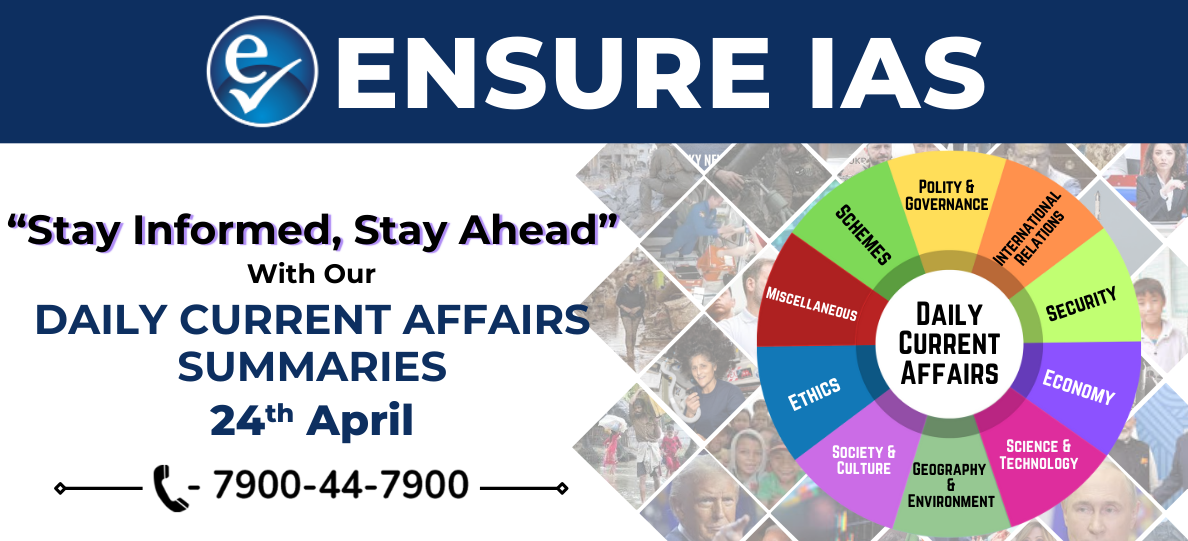- Courses
- GS Full Course 1 Year
- GS Full Course 2 Year
- GS Full Course 3 Year
- GS Full Course Till Selection
- Answer Alpha: Mains 2025 Mentorship
- MEP (Mains Enrichment Programme) Data, Facts
- Essay Target – 150+ Marks
- Online Program
- GS Recorded Course
- Polity
- Geography
- Economy
- Ancient, Medieval and Art & Culture AMAC
- Modern India, Post Independence & World History
- Environment
- Governance
- Science & Technology
- International Relations and Internal Security
- Disaster Management
- Ethics
- NCERT Current Affairs
- Indian Society and Social Issue
- NCERT- Science and Technology
- NCERT - Geography
- NCERT - Ancient History
- NCERT- World History
- NCERT Modern History
- CSAT
- 5 LAYERED ARJUNA Mentorship
- Public Administration Optional
- ABOUT US
- OUR TOPPERS
- TEST SERIES
- FREE STUDY MATERIAL
- VIDEOS
- CONTACT US
Daily Current Affairs Summary 24th APRIL 2025
Daily Current Affairs Summary 24th APRIL 2025

Mehrgarh Archaeological Site: An Overview
- Mehrgarh is a Neolithic archaeological site located at the mouth of the Bolan Pass in modern-day Balochistan, Pakistan.
- New radiocarbon dating using Accelerator Mass Spectrometry (AMS) has revised the age of the site, pushing the date of farming settlements back from 8000 BCE to 5200 BCE.
Key Features of Mehrgarh:
- Neolithic Settlement: Mehrgarh is one of the earliest known farming villages in South Asia.
- Farming Practices: The site shows evidence of early agriculture, including the domestication of wheat, barley, and cattle.
- Cotton Cultivation: It is home to the earliest known example of cotton cultivation in the Old World.
- Continuous Occupation: The site was occupied for more than 3 millennia, predating the Harappan Civilization.
- Mud Brick Structures: Well-preserved mud brick buildings indicate advanced construction techniques.
- Burials and Artifacts: The site contains numerous burial sites and a rich array of pottery, including the distinctive "Togau" style.
Davis Strait Proto-Microcontinent
Scientists have uncovered a hidden landmass beneath Greenland’s ice, known as the Davis Strait Proto-Microcontinent.
What is a Proto-Microcontinent?
- Proto-microcontinents are regions of relatively thick continental lithosphere.
- These areas are separated from major landmasses by a zone of thinner continental lithosphere.
Davis Strait Proto-Microcontinent: Key Details
- The Davis Strait Proto-Microcontinent is a newly identified submerged microcontinental fragment.
- It lies beneath the Davis Strait, which connects the Labrador Sea and Baffin Bay.
- Researchers believe this landmass was partially separated during ancient tectonic shifts.
- Despite these shifts, it did not fully detach from the surrounding continents.
- As a result, it became stranded beneath the seafloor, buried under layers of sediment and water.
Standing Deposit Facility (SDF)
The Standing Deposit Facility (SDF) has completed three years since its introduction as part of the Reserve Bank of India’s (RBI) liquidity management framework.
Key Features of the SDF:
- Monetary Tool: SDF is designed to absorb liquidity from commercial banks without requiring collateral.
- No Government Securities Needed: Unlike other tools, the government does not need to provide securities to banks for deposits.
- Replacement of Fixed Rate Reverse Repo: SDF replaced the Fixed Rate Reverse Repo as the floor of the Liquidity Adjustment Facility (LAF) corridor.
- Overnight Liquidity Absorption: It serves as an overnight liquidity absorption mechanism, though the RBI has the flexibility to extend its duration.
- Eligibility: Any entity eligible for LAF can access the SDF.
- Availability: The facility is available every day, including weekends and holidays.
Government has amended the Tobacco Board Rules, 1976,
The Government has amended the Tobacco Board Rules, 1976, extending the validity of registration for Virginia tobacco growers from 1 year to 3 years.
About Tobacco:
Origin: Tobacco is believed to have originated in South America and there are over 60 species of tobacco.
Ideal Growing Conditions for Tobacco:
- Temperature: Tobacco grows best in temperatures between 20°C and 27°C.
- Rainfall: Requires a minimum of 500 mm of rainfall; conditions are not suitable for cultivation in areas with more than 1200 mm of rainfall.
- Soil: Prefers sandy or sandy loam soil.
- Frost-Free Period: A frost-free period of 90 to 120 days is ideal for tobacco cultivation.
Tobacco Production in India:
- Global Status: India is the second-largest producer of tobacco in the world, after China, and the second-largest exporter of unmanufactured tobacco.
- Major Tobacco-Producing States: Tobacco is primarily cultivated in Gujarat (which accounts for 30% of production), Andhra Pradesh, Karnataka, Uttar Pradesh, and Bihar.
Arun-3 Hydroelectric Project
India and Nepal recently inaugurated the commencement of electromechanical works for the Arun-3 Hydroelectric Project, ensuring its timely completion.
About Arun-3 Hydroelectric Project:
- Location: The project is located on the Arun River, a tributary of the Kosi River, in the Sankhuwasabha District of Eastern Nepal.
- Project Type: It is a 900 MW Run-of-River scheme.
- Development and Operation: The project is being developed by the SJVN Arun-III Power Development Company (SAPDC) on a Build-Own-Operate-Transfer (BOOT) basis.
- Duration: The agreement spans 30 years, including a 5-year construction period.
- Partnership: SAPDC is a wholly-owned subsidiary of India’s Satluj Jal Vidyut Nigam (SJVN), highlighting significant collaboration between SJVN and the Government of Nepal.
Aadhaar authentication mandatory to avail benefits under the e-NAM scheme
The Union Agriculture Ministry has made Aadhaar authentication mandatory for individuals and farmer groups to avail benefits under the e-NAM (National Agriculture Market) scheme.
Legal Framework:
Aadhaar Act, 2016: Section 7 of the Aadhaar Act mandates Aadhaar-based authentication to avail any subsidy, benefit, or service funded by the Consolidated Fund of India.
About Aadhaar:
- Features: Aadhaar is a 12-digit individual identification number that serves as proof of identity and address. It is not a proof of citizenship or domicile.
- Data Included: Aadhaar contains both biometric (fingerprints, iris scan) and demographic (name, address, date of birth) information.
- Issued By: The Unique Identification Authority of India (UIDAI) is responsible for issuing Aadhaar numbers.
- Eligibility: Any resident of India, regardless of age or gender, is eligible to obtain an Aadhaar number.
Taj Trapezium Zone (TTZ)
The Supreme Court has directed the National Environmental Engineering Research Institute (NEERI) to assess the impact of the neighboring glass industry on the Taj Mahal.
Historical Context:
The Supreme Court has issued several orders over time for the protection of the Taj Trapezium Zone (TTZ), such as the 1996 ban on the use of coal and coke in industries within the zone.
About Taj Trapezium Zone (TTZ):
- Location: The TTZ covers an area of 10,400 square kilometers, shaped like a trapezoid, surrounding the Taj Mahal to protect it from pollution.
- Coverage: The zone includes three UNESCO World Heritage Sites: Taj Mahal, Agra Fort, and Fatehpur Sikri.
- Regulatory Authority: The Taj Trapezium Zone Pollution (Prevention and Control) Authority was established under the Environment Protection Act, 1986, to regulate pollution levels in the area.
- Industrial Categories: Industries within the TTZ are categorized into four groups—Red, Green, Orange, and White—based on their environmental impact.
Vulture Conservation and Breeding Centre (VCBC): An Overview
In a significant development, 34 critically endangered vultures were transferred from the Vulture Conservation Breeding Centre (VCBC) in Pinjore, Haryana, to Maharashtra for conservation efforts.
About VCBC, Pinjore:
- Genesis: The VCBC was established in 2001 with funding from the UK Government's Darwin Initiative for the Survival of Species.
- Key Partners: The centre is a joint effort between the Haryana Forest Department and the Bombay Natural History Society (BNHS).
- Conservation Goal: The primary aim of the centre is to protect three species of vultures: the White-backed, Long-billed, and Slender-billed vultures.
- Location: It is situated on the edge of the Bir Shikargaha Wildlife Sanctuary in Haryana.
- Major Achievement: The centre confirmed that diclofenac, a non-steroidal anti-inflammatory drug, was the primary cause of vulture mortality.
|
Also Read |
|
UPSC Foundation Course |
|
| UPSC Monthly Magazine | CSAT Foundation Course |




